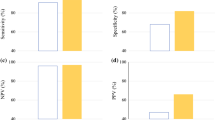Abstract
Introduction
We performed Thyroseq v2 molecular testing on indeterminate thyroid nodules and evaluated whether they underwent a management change from the standard of thyroid lobectomy.
Methods
We conducted a retrospective analysis of all indeterminate thyroid nodules that underwent Thyroseq v2 molecular testing from 2014 to 2019 at a large academic center. Pathology was reviewed by thyroid cytopathologists. Thyroseq results were reported benign (malignancy probability less than 10%) or suspicious (malignancy probability greater than 30%). The primary endpoint was a management change from a diagnostic lobectomy.
Results
A total of 142 nodules were included: 113 (80%) Bethesda III and 29 (20%) Bethesda IV. Seventy-three nodules underwent surgical management and 69 did not. We noted a change in management in 64% (91/142) of nodules. Patients who underwent a change in management to no surgery had a significantly higher rate of benign Thyroseq result than those without a change (75.8% vs. 49.0%, p = 0.001). On logistic regression analysis, a benign Thyroseq result was a positive independent predictor of a change to no surgery (OR 3.87, 95% CI 1.69–8.89). Nodule size, multiple nodules, compressive symptoms, and history of hypothyroidism were not significant. Of the 91 patients who underwent a management change, 71% (65/91) did not undergo surgery. On follow-up (average 985 ± 615 days), 12% (8/65) of those nodules were growing or developed suspicious features requiring surgery.
Conclusions
Molecular testing helped avoid surgery in almost half our population with indeterminate thyroid nodules, and benign results may help avoid surgery in asymptomatic patients with indeterminate thyroid nodules.


Similar content being viewed by others
References
Siegel RL et al (2021) Cancer statistics, 2021. CA Cancer J Clin 71(1):7–33
Cibas ES, Ali SZ (2009) The Bethesda system for reporting thyroid cytopathology. Thyroid 19(11):1159–1165
Bongiovanni M et al (2012) The Bethesda system for reporting thyroid cytopathology: a meta-analysis. Acta Cytol 56(4):333–339
Haugen BR et al (2016) 2015 American thyroid association management guidelines for adult patients with thyroid nodules and differentiated thyroid cancer: the American thyroid association guidelines task force on thyroid nodules and differentiated thyroid cancer. Thyroid 26(1):1–133
Nikiforova MN et al (2013) Targeted next-generation sequencing panel (ThyroSeq) for detection of mutations in thyroid cancer. J Clin Endocrinol Metab 98(11):E1852–E1860
Ho AS et al (2014) Malignancy rate in thyroid nodules classified as Bethesda category III (AUS/FLUS). Thyroid 24(5):832–839
Yaprak Bayrak B, Eruyar AT (2020) Malignancy rates for Bethesda III and IV thyroid nodules: a retrospective study of the correlation between fine-needle aspiration cytology and histopathology. BMC Endocr Disord 20(1):48
Aragon Han P et al (2014) The impact of molecular testing on the surgical management of patients with thyroid nodules. Ann Surg Oncol 21(6):1862–1869
Noureldine SI et al (2015) Effect of gene expression classifier molecular testing on the surgical decision-making process for patients with thyroid nodules. JAMA Otolaryngol Head Neck Surg 141(12):1082–1088
Noureldine SI et al (2016) Evaluation of the effect of diagnostic molecular testing on the surgical decision-making process for patients with thyroid nodules. JAMA Otolaryngol Head Neck Surg 142(7):676–682
Jug R et al (2019) Negative results on thyroid molecular testing decrease rates of surgery for indeterminate thyroid nodules. Endocr Pathol 30(2):134–137
Samulski TD et al (2016) Usage trends and performance characteristics of a “gene expression classifier” in the management of thyroid nodules: an institutional experience. Diagn Cytopathol 44(11):867–873
Marcadis AR et al (2019) Interinstitutional variation in predictive value of the ThyroSeq v2 genomic classifier for cytologically indeterminate thyroid nodules. Surgery 165(1):17–24
Taye A et al (2018) Clinical performance of a next-generation sequencing assay (ThyroSeq v2) in the evaluation of indeterminate thyroid nodules. Surgery 163(1):97–103
Nikiforov YE et al (2014) Highly accurate diagnosis of cancer in thyroid nodules with follicular neoplasm/suspicious for a follicular neoplasm cytology by ThyroSeq v2 next-generation sequencing assay. Cancer 120(23):3627–3634
Shrestha RT et al (2016) Correlation between histological diagnosis and mutational panel testing of thyroid nodules: a 2-year institutional experience. Thyroid 26(8):1068–1076
Patel SG et al (2017) Preoperative detection of RAS mutation may guide extent of thyroidectomy. Surgery 161(1):168–175
Su X et al (2016) Diagnostic value of BRAF (V600E)-mutation analysis in fine-needle aspiration of thyroid nodules: a meta-analysis. Onco Targets Ther 9:2495–2509
Acknowledgements
None.
Author information
Authors and Affiliations
Corresponding author
Ethics declarations
Conflict of interest
No authors have any conflict of interest.
Ethical approval
Study was approved by the Icahn School of Medicine at Mount Sinai Institutional Review Board.
Additional information
Publisher's Note
Springer Nature remains neutral with regard to jurisdictional claims in published maps and institutional affiliations.
Rights and permissions
Springer Nature or its licensor holds exclusive rights to this article under a publishing agreement with the author(s) or other rightsholder(s); author self-archiving of the accepted manuscript version of this article is solely governed by the terms of such publishing agreement and applicable law.
About this article
Cite this article
Steinmetz, D., Kim, M., Choi, JH. et al. How Effective is the Use of Molecular Testing in Preoperative Decision Making for Management of Indeterminate Thyroid Nodules?. World J Surg 46, 3043–3050 (2022). https://doi.org/10.1007/s00268-022-06744-1
Accepted:
Published:
Issue Date:
DOI: https://doi.org/10.1007/s00268-022-06744-1




